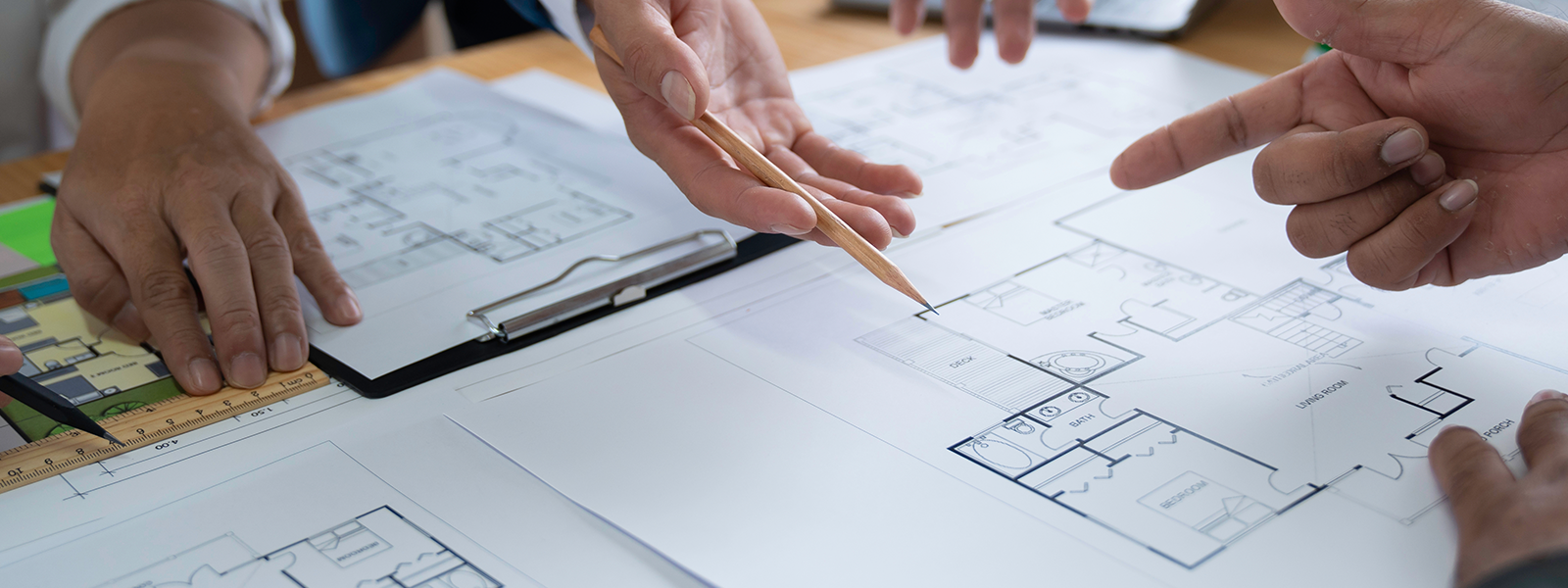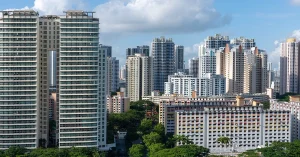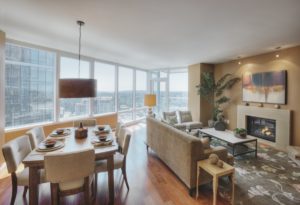Understanding the fundamental differences between carpet area, built-up area, and super built-up area is essential for every prospective homebuyer and real estate investor. These three measurement terminologies determine not only the actual usable space you receive but also significantly impact the property’s pricing structure. With the implementation of the Real Estate (Regulation and Development) Act 2016 (RERA), transparency in area calculations has become mandatory, making it crucial for buyers to comprehend these concepts thoroughly.
Table of Contents
What is Carpet Area?
Carpet area represents the most critical measurement for homebuyers as it defines the actual usable floor space within your property. According to RERA guidelines, carpet area is defined as “the net usable floor area of an apartment, excluding the area covered by external walls, areas under service shafts, exclusive balcony or verandah area, and exclusive open terrace area, but includes the area covered by internal partition walls of the apartment”.
In simple terms, the area in the flat or the apartment, which you could cover using a carpet, is the carpet area. Also known as the net usable area, the carpet area is actually that space in your home that can be used for laying a carpet. It includes the thickness of the internal wall but excludes the balcony or terrace. Technically, the distance between the inner walls is the carpet area. Also, it will include a staircase only if it is inside the apartment.
The real estate developers in India widely misused these terms by misinforming buyers about the real usable area and coined complicated terms to give a false sense of a large space. After the Real Estate (Regulation and Development) Act, 2016 (RERA) came into force, it is now mandatory for all builders to sell flats based on the carpet area.
=> Read Also:- What Does RERA Carpet Area Mean and How to Calculate it?
How to Calculate Carpet Area?
Calculating carpet area involves a straightforward process that helps determine your actual living space:
Formula: Carpet Area = (Area of bedroom + living room + kitchen + bathrooms + internal passages) – thickness of internal walls
Step-by-step calculation:
- Measure each room individually – Calculate length × width for every usable space
- Add all room areas together – Sum the individual areas of all rooms
- Subtract internal wall thickness – Deduct the space occupied by walls between rooms
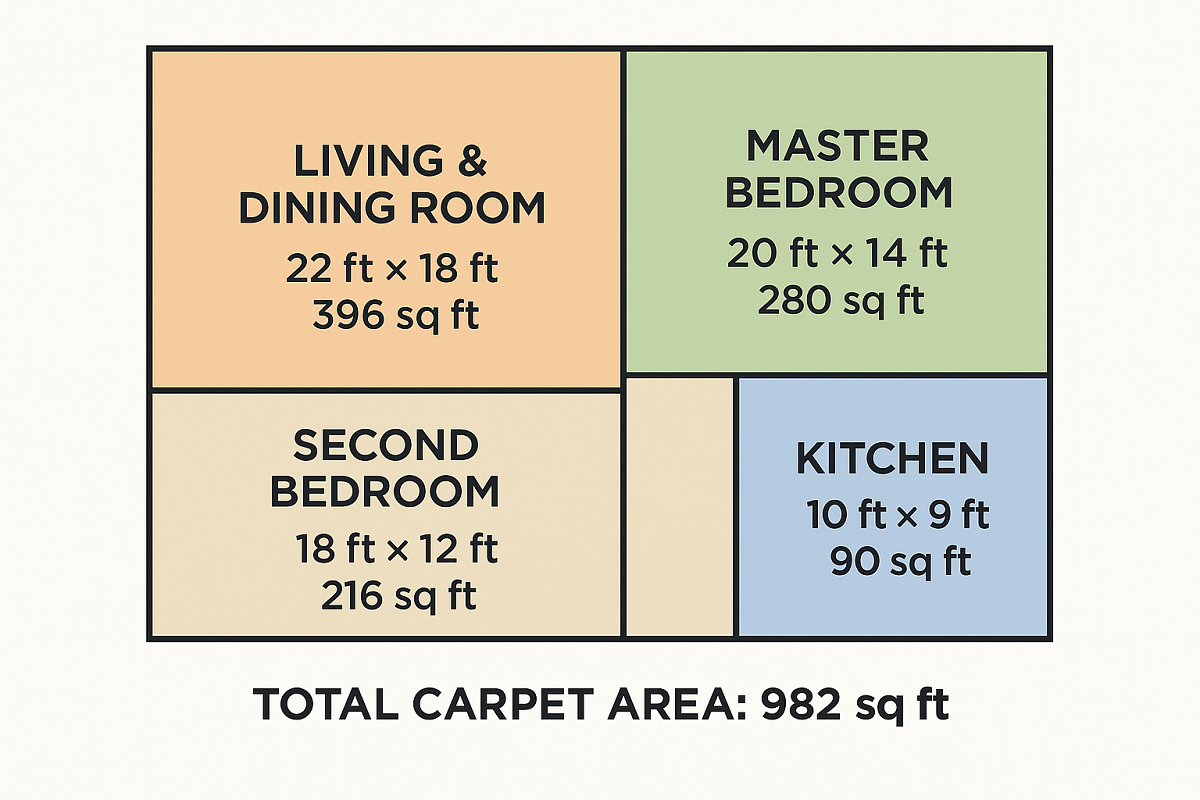
Example Calculation:
- Living & Dining Room: 22 ft × 18 ft = 396 sq ft
- Master Bedroom: 20 ft × 14 ft = 280 sq ft
- Second Bedroom: 18 ft × 12 ft = 216 sq ft
- Kitchen: 10 ft × 9 ft = 90 sq ft
- Total Carpet Area: 396 + 280 + 216 + 90 = 982 sq ft
Importance of Carpet Area in Property Transactions
Understanding carpet area is crucial for several reasons that directly impact your investment decision:
Transparent Pricing Structure: RERA mandates that builders must quote property prices based solely on carpet area, eliminating misleading pricing practices. This ensures you pay only for the space you can actually use.
Accurate Space Assessment: Carpet area provides the most realistic picture of your living space, helping you determine if the property meets your lifestyle requirements and furniture placement needs.
Property Comparison: When comparing different properties, carpet area serves as the standardized measurement unit, allowing for fair and accurate comparisons across various developments.
Bank Loan Calculations: Financial institutions primarily consider carpet area for property valuation and loan disbursement, making it critical for your financing arrangements.
What is the Built-Up Area?
Built-up area represents a broader measurement that includes the carpet area along with additional structural components. This measurement provides a comprehensive view of the total constructed space within your apartment unit.
The built-up area includes the carpet area along with the thickness of the walls. It encompasses all enclosed spaces within the apartment, such as rooms, corridors, and balconies. Calculating the built-up area involves considering the internal dimensions and wall thickness.
Components of Built-Up Area
Built-up area encompasses several elements beyond the basic living space:
- Complete carpet area – All usable floor space within walls
- Wall thickness – Both internal and external wall areas
- Balconies and terraces – Covered and uncovered attached spaces
- Exclusive utility areas – Private service areas within your unit
- Internal staircases – Private stairs within multi-level units
How to Calculate Built-Up Area?
The calculation for built-up area follows a systematic approach that accounts for all covered spaces:
Formula: Built-up Area = Carpet Area + Wall Areas + Balconies + Terraces + Exclusive Utility Areas
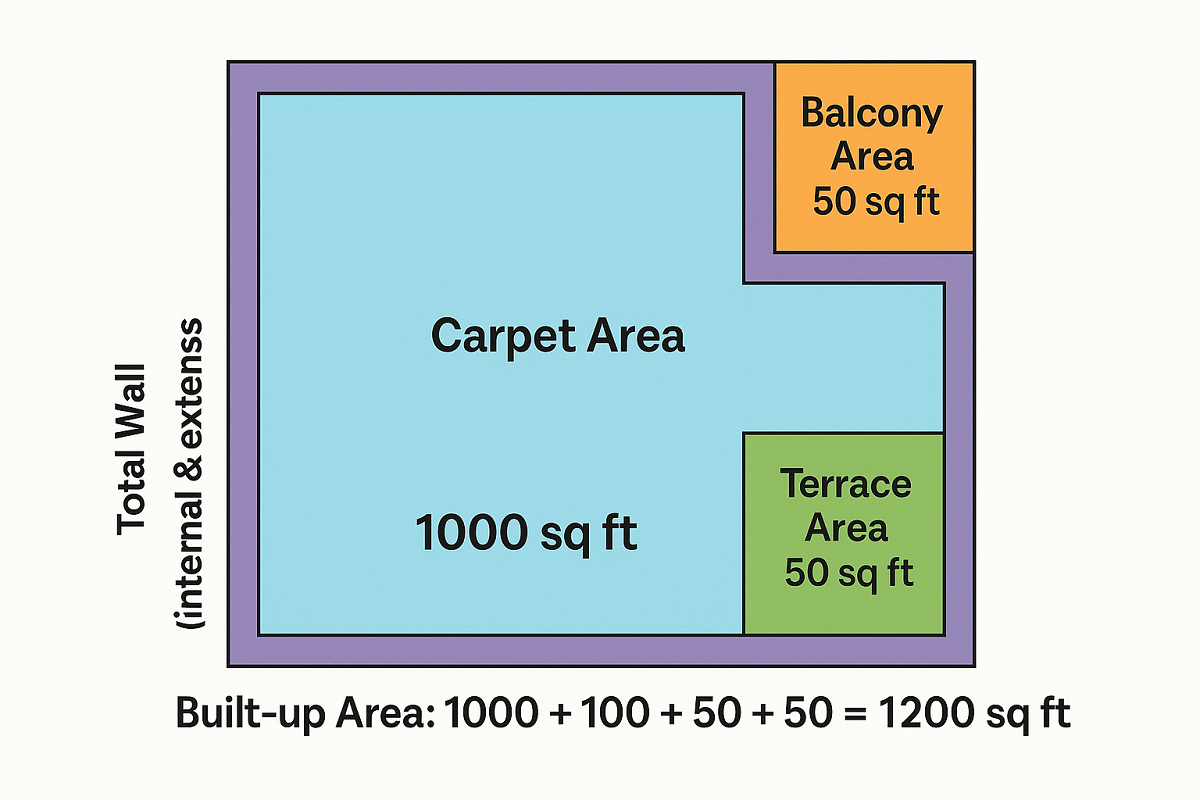
Practical Example:
- Carpet Area: 1,000 sq ft
- Total wall thickness (internal & external): 100 sq ft
- Balcony area: 50 sq ft
- Terrace area: 50 sq ft
- Built-up Area: 1,000 + 100 + 50 + 50 = 1,200 sq ft
Why Built-Up Area Matters
Built-up area serves specific purposes in real estate transactions:
Comprehensive Space Understanding: It provides insight into the total constructed space, helping buyers understand the complete unit size including structural elements.
Construction Cost Assessment: Builders often use built-up area calculations for construction cost estimation and material planning.
Comparative Analysis: When comparing properties with different architectural styles, built-up area helps evaluate the efficiency of space utilization.
=> Read Also:- The Difference Between Carpet Area and Built-Up Area
What is Super Built-Up Area
Super built-up area, also known as saleable area, represents the most comprehensive measurement in real estate transactions. This figure includes your exclusive built-up area plus a proportionate share of all common areas and amenities within the building complex.
The super built-up area extends beyond the built-up area and includes common spaces, amenities, and shared facilities like staircases, lobbies, and gardens. It represents the total area a buyer pays for, including their proportionate share of the common spaces.
How to Calculate Super Built-Up Area?
Here’s a step-by-step guide on how to calculate super built-up area:
Step 1: Find the Carpet Area
Measure the actual usable floor space:
- Living room: 20 ft × 15 ft = 300 sq ft
- Master bedroom: 15 ft × 12 ft = 180 sq ft
- Second bedroom: 12 ft × 10 ft = 120 sq ft
- Kitchen: 10 ft × 8 ft = 80 sq ft
- Bathrooms: 6 ft × 6 ft each = 72 sq ft
- Corridors: 50 sq ft
Total Carpet Area = 300 + 180 + 120 + 80 + 72 + 50 = 802 sq ft
Step 2: Calculate Built-Up Area
Add wall thickness and balcony areas:
- Carpet Area: 802 sq ft
- Wall thickness (15% of carpet area): 802 × 0.15 = 120 sq ft
- Balcony area: 80 sq ft
Built-Up Area = 802 + 120 + 80 = 1,002 sq ft
Step 3: Determine the Loading Factor
The developer tells you the loading factor is 30% (0.30)
Step 4: Apply the Loading Factor
Using the simple formula:
Super Built-Up Area = Carpet Area × (1 + Loading Factor)
Super Built-Up Area = 802 × (1 + 0.30) = 802 × 1.30 = 1,043 sq ft
Step 5: Verify with Quick Check
Loading Factor Check = (1,043 – 802) ÷ 802 × 100 = 30% ✓
Final Result:
- Carpet Area: 802 sq ft (what you actually live in)
- Built-Up Area: 1,002 sq ft (includes walls and balcony)
- Super Built-Up Area: 1,043 sq ft (what you pay for)
- Loading Factor: 30%
Price Calculation: If the rate is ₹8,000 per sq ft of super built-up area:
Total Cost = 1,043 × ₹8,000 = ₹83,44,000
Importance of super built-up area
Understanding super built-up area is crucial for several financial and practical reasons:
Pricing Implications: Most developers price properties based on super built-up area, making it essential to understand what you’re paying for.
Amenity Access: The common area portion determines your access to shared facilities like gyms, swimming pools, and community halls.
Maintenance Costs: Your proportionate share of common areas affects ongoing maintenance expenses.
Investment Analysis: For rental properties, understanding the super built-up area helps evaluate the cost per square foot of actual usable space.
Difference Between Carpet Area, Built-up Area, and Super Built-up Area
Conclusion
Understanding the differences between carpet area, built-up area, and super built-up area is fundamental to making successful real estate investments. Carpet area represents your actual living space and serves as the legal basis for transparent pricing under RERA regulations. Built-up area provides insight into the total constructed space including structural elements, while super built-up area encompasses your share of common facilities and amenities.
The key to successful property evaluation lies in focusing on carpet area for space and pricing analysis, understanding built-up area for construction quality assessment, and evaluating super built-up area for amenity value proposition. With RERA’s mandate for transparent area disclosure, buyers now have the tools necessary to make informed decisions based on accurate measurements rather than misleading marketing figures.
By applying this knowledge systematically and avoiding common evaluation mistakes, you can ensure that your property investment provides genuine value in terms of both usable space and long-term appreciation potential. Remember to always verify area calculations through official RERA documents and demand detailed breakdowns from developers to protect your investment interests.
Ganga Realty, the best real estate company in Gurgaon, exemplifies these best practices through flagship projects like Nandaka Sector 84 and Anantam Sector 85, which offer clear area disclosures, efficient design, and premium amenities—ensuring that buyers receive both transparency and long-term value.
Frequently Asked Questions
Why do developers price properties on the basis of super built-up area?
Super built-up area incorporates your built-up area plus a proportionate share of common areas (lobbies, corridors, amenities). Developers use this metric to include community facilities in the price, though RERA mandates that the carpet area rate must also be disclosed.
Which area measurement should I use to compare different property options?
Always compare properties using carpet area for a true apples-to-apples comparison of usable living space. Pricing per carpet-area square foot gives the most accurate value assessment.
Is carpet area the only basis for obtaining a home loan?
Most banks evaluate your loan based on the carpet area, as it represents the actual living space. They may also request built-up area details for collateral valuation, but carpet area remains primary.
Does RERA regulate built-up and super built-up areas?
RERA mandates that all property pricing must be transparently quoted on a carpet area basis. While built-up and super built-up figures can still be marketed, developers must disclose carpet-area rates and provide detailed area breakdowns.
How much smaller is carpet area compared to super built-up area?
Carpet area is typically 70–85% of the super built-up area. The exact percentage depends on the loading factor; higher loading factors reduce the proportion of actual usable space.
Are parking spaces included in super built-up area?
Typically, covered parking may be included proportionately in the super built-up area, whereas open parking and driveways are usually excluded.
